| Assessing Gaps to Support Prioritization: Solving complex societal issues increasingly depends on information and knowledge derived from Earth observations and in Europe a rich landscape of Earth observation networks and actors aims to collect and process the necessary observations to satisfy these information and knowledge needs. Nevertheless, there are many gaps and the goal is to identify and assess these gaps in support of decisions on which gaps to address with high priority. |
The workshops addressed key issues associated with the societal benefits of Earth observations and the exploitation of Earth observation for societal policy and decision making.
SCOPE AND OBJECTIVES OF THE GAP ANALYSIS WORKSHOP
| Providing Earth Observation Support to the Monitoring and Implementation of the Sustainable Development Goals: Gaps and Priorities: Solving complex societal issues increasingly depends on information and knowledge derived from Earth observations and in Europe a rich landscape of Earth observation networks and actors aims to collect and process the necessary observations to satisfy these information and knowledge needs. Nevertheless, there are many gaps and the goal is to identify and assess these gaps in support of decisions on which gaps to address with high priority.
|
The Gap Analysis workshop discussed the outcomes of the gap analysis and prioritization performed in the ConnectinGEO project. This gap analysis was guided by the information and knowledge needs resulting from humanity's “Road to Dignity” detailed in the Agenda 2030 and specified in the 17 Sustainable Development Goals (SDGs) agreed upon by the United Nations. Both the monitoring and implementation of actions to achieve these goals require extensive support from Earth observation and science communities. Several directives and crosscuting issues in Europe provided further guidance for the gap analysis.
The workshop provided a forum to review the methodology for gap analysis and prioritization, discussed the relevant gaps and priorities in the European Earth observation networks and developed a strategy to address those gaps that have a high priority assigned.
The objectives of the gap analysis and prioritization workshop were to:
- Assess the ConnectinGEO methodology for gap analysis and prioritization;
- Review the list of gaps identified and the prioritization achieved;
- Produce a final list of gaps with high priority;
- Discuss a strategy to address these gaps and provide recommendations for the European Network of Earth Observation Networks (ENEON) and the European Commission concerning high-priority gaps.
OUTPUT
OUTPUT OF THE GAP ANALYSIS AND PRIORITIZATION WORKSHOP
The high-level output of the Gap Analysis and Prioritization Workshop will be a report describing the gap analysis and prioritization methodology developed in ConnectinGEO and providing a detailed list of prioritized gaps.
PROGRAM AND SCHEDULE
PROGRAM
Note that changes in the program will be made as speakers are identified.
Monday, October 10, 2016
| 1200 - 1330: | Registration |
| 1330 - 1530: | Introduction to the ConnectinGEO Approach to Gap Analysis and Prioritization (Chairs: Ian McCallum, Steffen Fritz) |
| 1330 - 1340 | Steffen Fritz (IIASA): Welcome to IIASA |
| 1340 - 1405 | Michael Obersteiner (IIASA): IIASA, Earth Observations and the Sustainable Development Goals (presentation) |
| 1405 - 1430 | Ivette Serral (CREAF): The ConnectinGEO project (presentation) |
| 1430 - 1500 | Giovanni Rum (GEO Secretariat): GEO's approach to User need definition and Gap Analysis (presentation) |
| 1500 - 1530 | de Maziere, M., Thorne, P., van Weele, M. and the GAIA-CLIM project team: GAIA-CLIM Gap Analysis (presentation) |
| 1530 - 1600: | Coffee Break |
| 1600 - 1800: | Session 2: “Top-Down” approach to Gap Analysis: Thread 1: Identification of a collection of observation requirements;
Thread 2: Research programs aims and targets (Chairs: Hans-Peter Plag and Joan Maso)
|
| 1555 - 1605 | Hans-Peter Plag: Remarks on the Workshop Goals and Expected Outcomes |
| 1605 - 1625 | Joan Maso (CREAF): The ConnectinGEO Approach to Gap Analysis (presentation) |
| 1625 - 1650 | E. Garcia-Ladona, Joan Maso, Ivette Serral and ConnectinGEO team: Gap analysis for the marine component within ConnectinGEO (abstract, presentation) |
| 1650 - 1715 | Daniele Ehrlich (JRC), Martino Pesaresi, Thomas Kemper: The GHSL framework for monitoring International Framework Agreements (abstract, presentation) |
| 1715 - 1745 | Hans-Peter Plag et al.: From Essential Variables to Observational Requirements: The SEE-IN KB: Bringing it all Together for Gap Analysis (presentation)
|
| 1745 - 1800 | Discussion: How can the gaps in available observations be identified and how can they be closed?
|
Tuesday, October 11, 2016
| 0830 - 0900: | Registration |
| 0900 - 1200: | Session 3: “Bottom-Up” approach to Gap Analysis: Thread 1: Consultation process; Thread 2: GEOSS Discovery and Access Broker analysis and Thread 3: Industry-Driven Challenges (Chairs: Ian McCallum, Stefano Nativi, and Lionel Menard)
|
| 0900 - 0940 | Matthes Rieke et al.: Summary of Bottom-Up Thread 1 (presentation) |
| 0940 - 1020 | Kjetil Tørseth: Air pollution and air quality monitoring in Europe: Gaps limiting further developments (abstract, presentation) |
| 1020 - 1100 | Mattia Santoro and/or Stefano Nativi: Summary of Bottom-Up Thread 2 (presentation) |
| 1100 - 1130: | Coffee Break |
| 1130 - 1200 | Mónica Miguel Lago: Summary of Bottom-Up Thread 3 (presentation) |
| 1200 - 1430: | Session 4: Making Gap Analysis Results Usable (Chairs: Giovanni Rum)
|
| 1200 - 1240 | van Weele, M., de Maziere, M., Thorne, P. and the GAIA-CLIM project team: The GAIA-CLIM online Catalogue of Gaps and Gaps Assessment and Impacts Document (abstract, presentation) |
| 1240 - 1400: | Lunch |
| 1400 - 1430 | Haris Konteos: The GAP Analysis process in the GEO-CRADLE project (abstract, presentation) |
| 1430 - 1630: | Session 5: Assessment of the Gaps Identified so far (Chairs: Joan Maso)
|
| 1430 - 1510 | Hans-Peter Plag: Assessment of Gap Analysis Outcomes and Integrating Gap Analysis in the SEE-IN Knowledge Base (presentation) |
| 1510 - 1520 | All: Distribution of gaps to groups and introduction of the questions |
| 1520 - 1610 | Group discussions:
- Group 1 (chair&rapporteur Joan Maso): Gaps about: Climate, biodiversity, oceans
- Group 2 (chair&rapporteur Hans-Peter Plag): Gaps about: water, energy, disasters
- Group 3 (chair&rapporteur Siri Jodha Khalsa): Gaps about: transversal issues
|
| | 1610 - 1630: | Coffee Break |
| 1630 - 1700 | Rapporteurs: Brief Summary of Group Discussions |
| 1700 - 1815: | Session 6: Steps Towards Prioritization (Chairs: Giovanni Rum and Hans-Peter Plag) |
| 1700 - 1725 | Giovanni Rum: GEO's approach to Prioritization |
| 1725 - 1750 | Thorne, P., De Maziere, M., van Weele, M.: From a gaps analysis and impacts assessment to prioritization: the current GAIA-CLIM plans (abstract, presentation) |
| 1750 - 1810 | Hans-Peter Plag and Joan Maso: ConnectinGEO Prioritization: Actions for the Remaining Project Life-Time (presentation) |
| 1810 - 1815 | Joan Maso, Hans-Peter Plag, Ian McCallum: Wrap-Up and Closing of Workshop |
| 1900 - 2100: | Social Dinner in Laxenburg |
SCHEDULE
Overview October 10-14, 2016
Note that the Session titles are preliminary and may change to some extent in the next weeks.
| Date |
|
|---|
| Monday, October 10, 2016 |
| 08:30-13:00 | Pre-Workshop Meetings |
| 12:00-13:30 | Registration |
| 13:30-18:00 | Gap Analysis and Prioritization Workshop |
| 13:30-15:30 | Session 1: Introduction to the ConnectinGEO Approach to Gap Analysis and Prioritization |
| 15:30-16:00 | Coffee Break |
| 16:00-18:00 | Session 2: “Top-Down” approach to Gap Analysis: Thread 1: Identification of a collection of observation requirements;
Thread 2: Research programs aims and targets |
|
| Tuesday, October 11, 2016 |
| 08:30-09:00 | Registration |
| 09:00-18:00 | Gap Analysis and Prioritization Workshop |
| 09:00-10:30 | Session 3: “Bottom-Up” approaches to Gap Analysis: Thread 1: Consultation process, Thread 2: GEOSS Discovery and Access Broker analysis and Thread 3: Industry-Driven Challenges |
| 10:30-11:00 | Coffee Break |
| 11:00-12:30 | Session 4: Making Gap Analysis Results Usable |
| 12:30-13:30 | Lunch |
| 13:30-15:30 | Session 5: Assessment of the Gaps Identified so far |
| 15:30-16:00 | Coffee Break |
| 16:00-18:00 | Session 6: Steps Towards Prioritization |
| 19:00-21:00 | No-Host Dinner |
|
| Wednesday, October 12, 2016 |
| 08:30-09:00 | Registration |
| 09:00-18:00 | ENEON Workshop |
| 09:00-10:30 | Session 1: ConnectinGEO and ENEON: Introduction and Achievements |
| 10:30-11:00 | Coffee Break |
| 11:00-12:30 | Session 2: ENEON in Support of European Policy Making and Implementation |
| 12:30-13:30 | Lunch |
| 13:30-15:30 | Session 3: ENEON support to GEO activities: a European Contribution to the GEO Work Programme |
| 15:30-16:00 | Coffee Break |
| 16:00-18:00 | Session 4: The Future of ENEON |
| 19:00-21:00 | No-Host Dinner |
|
| Thursday, October 13, 2016 |
| 08:30-09:00 | Registration |
| 09:00-12:30 | ENEON Workshop |
| 09:00-10:30 | Session 5: The Future of ENEON |
| 10:30-11:00 | Coffee Break |
| 11:00-12:30 | Session 6: ENEON Business and Wrap-Up (open session) |
| 12:30-13:30 | Lunch |
| 13:30-18:00 | ConnectinGEO Project Meeting |
|
| Friday, October 14, 2016 |
| 08:30-09:00 | Registration |
| 09:00-12:30 | ConnectinGEO Project Meeting |
|
PRACTICAL DETAILS
PARTICIPATION
The Gap Analysis and Prioritization Workshop and the ENEON Workshop are open to representatives of European groups, networks, and services engaged in European or global earth observation activities, including the maintenance of in situ networks and value-adding processing of observations to provide advanced products and services.
The ConnectinGEO Project meeting is by invitation only.
DEADLINES
Deadlines are identical for both workshops. Please, try to submit abstracts and register prior to the deadlines given below to support the planning of the event. However, abstracts and registrations will be accepted after the deadlines.
- Submission of abstracts: September 21, 2016.
- Registration deadline: September 21, 2016.
COMMITTEES
Local Organizing Committee:
- Ian McCallum
- Stephen Fritz
- Ivette Serral
Program Committee Gap Analysis and Prioritization Workshop:
- TIWAH: Hans-Peter Plag, Shelley Jules-Plag
- CREAF: Joan Masó, Ivette Serral
- IIASA: Ian McCallum
- GEO Secretariat: Giovanni Rum
- CMCC: Antonio Bombelli
- CNR-ISSIA: Palma Blonda
- IEEE: Jay Pearlman, Françoise Pearlman, Siri Jodha Khalsa
- CISC: Emili García-Ladona
- BIRA-IASB: Martine De Maziere
- NILU: Kjetil Tørseth, Wenche As
- ARMINES: Lionel Menard, Lucien Wald
ACKNOWLEDGEMENTS
Support for the Workshop
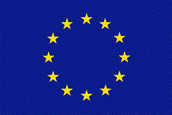 |
The workshops are organized as workshop of ConnectinGEO, a project which received funding from the European Union Framework Program for Research and Innovation (SC5-18a-2014) under grant agreement no. 641538. |
 |
The workshops are hosted by IIASA. |
 |
Tiwah supports the Workshop by hosting and maintaining the GSTSS. |
Technical Advice and Support for the Workshop
| |
The local organizing committee for the workshops is hosted by CREF, Barcelona. |
ABSTRACTS
Speakers are not asked to submit abstracts for their presentations. However, those who would like to provide an abstract are invited to do so by sending the abstract to hpplag @ tiwah.com. Abstracts made available prior to the events will be included in the program pages.
REGISTRATION
Go directly to the registration page (using EventBride). Note that you need to click on "Select a Date" first to get the page with the "Register" button. Select any of the dates and then click on "Register". After that, you can indicate which of the events you want to attend.
Pre-Registration is strongly recommended before September 21, 2016 to help the organizers in the planning of the events. To register for the individual events, a registration page is available here. Note that this page is using EventBride for the registration. You can indicate which of the three events you plan to attend. For the project team meeting, the organizers reserve the right to accept or reject applications from individuals not representing a project partner.
If you plan to present at one of the events, please use the abstract submission page to submit an abstract.
VENUE
The ConnectinGEO and ENEON workshops will take place at the International Institute of Applied Systems Analysis (IIASA) located in Laxenburg, Austria:
IIASA
Schlossplatz 1
A-2361 Laxenburg
Austria
Tel.: (+43-2236) 807 0
Fax: (+43-2236) 71313
E-mail: inf at iiasa.ac.at
Information on the specific meeting rooms will be provided on the program pages.
LOGISTICS
Contents
Travel Logistics
Getting to Laxenburg, Vienna and IIASA:
- From Airport to IIASA:
- The fastest and quickest option is to use a taxi. Public transport requires you to go first into Vienna, then South again to IIASA which takes 1.25-1.5 hours in total.
- By Taxi from the Airport or Vienna: A taxi from either the Airport or Vienna to Laxenburg will cost about €40-45 in both cases and take 30 minutes.
- From Vienna International Airport to Hotel Prinz Eugen and/or Motel One Wien-Hauptbahnhof:
- By public transportation from Vienna/Airport: From Vienna Airport you can take the City Airport Train (CAT) to the Wien Mitte/Landstrasse station (the journey takes 16 minutes). There are signs to the CAT train in the airport arrivals hall (http://www.cityairporttrain.com/Infos/Fahrplan.aspx). The shuttle costs €11 one way and €17 for a roundtrip. From here you have to walk – follow the signs, to connect to the underground. The CAT will take you to the Wien Mitte station in Vienna from which you can either:
- Take a taxi that costs ca. 10 EUR to your hotel — 5 minutes, or
- Take the U4 (green line) at Wien Mitte station changing at Karlsplatz to the U1 (red line) 2 stops and get off at Hauptbahnhof (Vienna Central Station). The Hotel Prinz Eugen is 450 meters and Motel One Wien Hauptbahnhof is 600 meters from the station. See the map below to get an overview of the area.

- You can also take the “schnellbahn” train from Vienna Airport into the city — this is a bit slower but cheaper than the CAT.
- You can also take a bus into the city — buses are parked just outside the departures area.
- The bus from Vienna to IIQASA in Laxenburg:
- Once in Vienna take the red U1 subway line to Hauptbahnhof Station.
- From Hauptbahnhof follow the bus signs to the exit Bus Terminal, which is located on the left hand side adjacent to the main entrance of the train station.
- We are arranging a charter bus scheduled to depart Vienna Hauptbahnhof at 8:30 am from Tuesday thru Friday (11-14 October). This bus will take you from Hauptbahnhof and will let you off at the bus stop Franz-Josefs-Platz. For that, at the Bus Terminal (Stand N2) in Hauptbahnhof (from the U1/red line stop follow the signs to the bus terminal) take the bus Laxenburg (200). Ian will be at the bus stop to direct you. The trip takes about 30 minutes and costs are covered by IIASA. The bus will leave promptly at 8:30 am!
- If you miss the 8:30 am bus, there is a 8:40 and a 9:10 Bus #200 that will take you to Laxenburg. Please get off at Franz-Josefs-Platz. The trip costs €4.40 for a one-way ticket. At the Bus Terminal (Stand N2) you can catch the #200 bus to Laxenburg (sometimes the bus destination may indicate Eisenstadt). Check with the driver whether the bus you are boarding is going to Laxenburg.
- When viewing the map of Laxenburg, the bus stop is located in the upper left hand corner near the Schloss Restaurant (marked by a bus symbol). The main entrance of the IIASA Schloss is indicated on the center of the map and is about a 2-minute walk from the bus stop.
- For the evenings, you will need to take a regular bus that will pass by the bus stop Franz-Josefs-Platz and take you to Hauptbahnhof. The evening bus schedule is 16:47, 17:17, 17:55, 18:17, and 19:17. For the full bus schedule see here.
- For the evening bus, you will need to pay yourself and the ticket costs €4.40 one way.
 
Location of Bus station and IIASA and the view of IIASA.
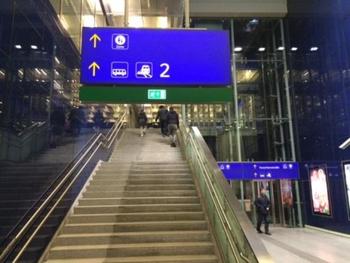
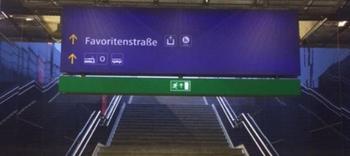
Follow the bus signs up to Favoritenstrasse.
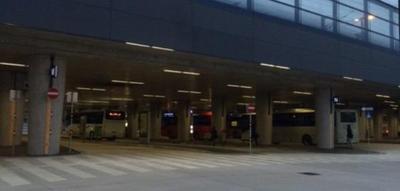
Cross the road to the bus terminal.
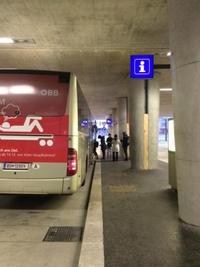

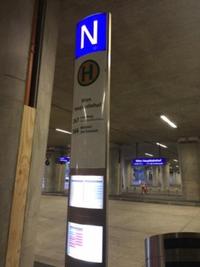
Bus 200 leaves from terminal N2.
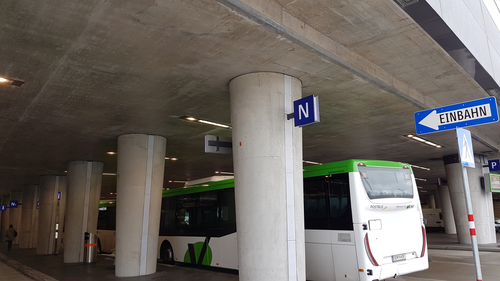
Back to contents
Climate and Weather
|
Climate in Laxenburg is moderate but warm. Throughout the whole year there is significant percipitation. The total amount of anual precipiation is on the order of 630 mm. Even the driest month January shows high amounts of precipitation with 34 mm on average. The month with the highest average precipitation is June with 77 mm. The annual average temperature is 9.9 oC.
| 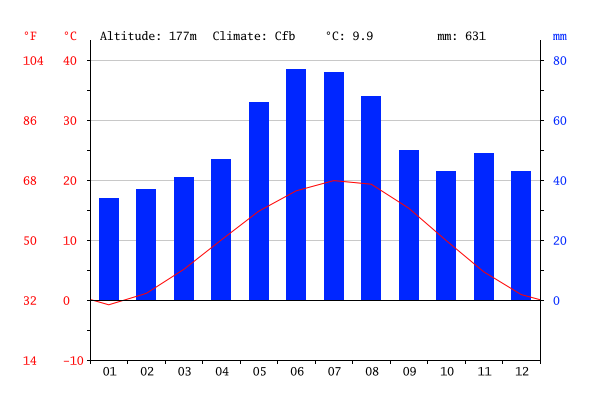
|
For weather, see the most recent full ten-day forecast for Vienna here, which is representative for Laxenburg.
Back to contents
Restaurants
See here for an overview of the local restaurants.
Back to contents
Workshop Dinner
A no-host dinner is planned for Monday evening at the Italian restaurant Gallo Rosso at 18:30. The restaurant is in Laxenburg across the street from the bus stop participants can take immediately after dinner back to the Hauptbahnhof in Vienna.
The plans for no-host dinners on other evenings have not been finalized. Information will be added here as it becomes available.
Back to contents
What to do and visit in Laxenburg?
See wikipedia and City Page for recommendations.
Back to contents
ACCOMMODATION
There are a limited number of hotels in the vicinity of the venue. However, using public transportation, many hotels in Vienna can be reached. A list of most recomended hotels is provided below.
In walking distance of the meeting venue:
The hotels below are the most recommended for the price and proximity to the Vienna Hauptbahnhof from where you will take the bus to IIASA (Laxenburg) which takes 35 minutes (see logistics). The hotels (Prinz Eugen, Motel One Wien Hauptbahnhof, Hotel Beim Theresianum) are all walking distance to the Hauptbahnhof. We were able to make a block booking for 25 rooms at the Hotel Prinz Eugen that were held until mid September, after which it will be based on the hotel's availability. Note that IIASA's rate at the respective hotels could have increased as it is dependent on time of year and availability.
Both hotels are located in the south of Vienna and provide convenient access to both the main train station (Hauptbahnhof) and the bus terminal to IIASA. The Hotel Prinz Eugen is 6 minutes and Motel One Wien-Hauptbahnhof is 4 minutes walking distance to the bus stop located directly under the bridge, where you could take the bus to get to IIASA.
HOTEL OPTIONS
Prinz Eugen****
Wiedner Gürtel 14, 1040 Vienna
Tel.: 505-17-41/Fax: 505-17-41-19
E-mail: prinzeugen@private-hotels.at — contact Birgit Pawel and quote our booking code: ENEON
We have 25 rooms blocked at the special rate of €75 Single/€85 Double occupancy which includes Wifi, breakfast and all taxes.
500 Meters from Vienna Hauptbahnhof
Motel One Wien-Hauptbahnhof
€70,74 (excl. breakfast) Single
€86,12 (excl. breakfast) Double
Hotel Beim Theresianum
Favoritenstrasse 52, 1040 Vienna
Tel.: 505-16-06-0/Fax: 505-16-06-09
E-mail: theresianum@austria-trend.at
Standard: €85
Business: €105
|
















